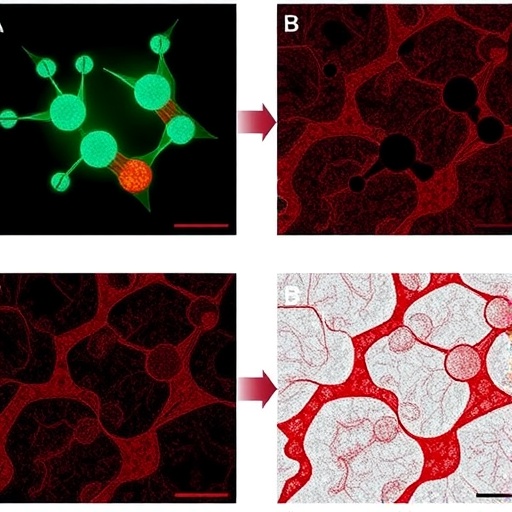
Credit: University of Colorado Cancer Center
More than a decade ago, radiation oncologists noticed a nifty phenomenon: Sometimes radiation used locally against a tumor could excite the immune system to attack cancer systemically throughout the body. It was as if the use of radiation had somehow awoken the immune system to the presence of cancer. Since then, a massive effort has been underway to harness this effect, hoping to create this systemic anti-cancer activity with combinations of radiotherapy and immunotherapy.
Unfortunately, “We’ve tried numerous combinations with radiotherapy – triple therapy, different targeted strategies – and still we cannot eradicate the tumors,” says Sana Karam, MD, PhD, investigator at CU Cancer Center and assistant professor of Radiation Oncology at the CU School of Medicine.
What is driving this resistance to radiotherapy? In a new study published in the Journal of the National Cancer Institute, Karam and colleagues show that it may be a special kind of immune cell called T-regulatory or Treg cells. Just as the body has mechanisms to turn on the immune system, it also has ways to turn it off, and Tregs are one of these ways, functioning like an ‘off’ switch that keeps the immune system from running rampant through healthy tissues.
“Tregs are immunosuppressant cells that put the brakes on the effector t cells. But Tregs also stop T cells from doing their job of killing the cancer cell,” Karam says.
In this study, with first author Ayman Oweida, PhD, radiation alone or Treg depletion alone wasn’t enough to kill head and neck cancer models grown in mice, but together these two strategies resulted in potent tumor reduction. The strategy makes sense: Radiation turned on the immune system, and the depletion of Tregs ensured that cancer was not able to turn it off.
“If you go at it just by taking away Tregs, there are no effector T cells. You need something to inflame the environment, something to excite T effector cells, and in this case that was the role of radiation,” Karam says.
Unfortunately, “We don’t have a good, safe agent that can eradicate Tregs safely in humans. The way we’re doing it is a good way to understand the biology, but it’s not a good strategy for patients,” Karam says.
Which is where the second line of research comes in. See, independent of Karam’s work with radiation and Tregs is her work with a program active in early embryonic development that many cancers restart to drive their growth. Specifically, a “handshake” between EphB4 and ephrinB2 is essential for neurogenesis in the developing brain, but previous work has shown that EphB4 and/or ephrinB2 are upregulated in many cancers, including head and neck, and pancreatic cancers.
“EphB4 has been studied not just in cancer, but in a lot of diseases where the immune system is key. In cancer, we’ve shown that when you inhibit the interaction between EphB4 and ephrinB2, you get a reduction in tumor growth – and we’re opening a trial at CU Cancer Center with a drug that inhibits EphB4-ephrinB2 interaction. But we also wanted to know why inhibiting this interaction acts against tumors,” Karam says.
The group’s paper recently published in the journal Cancer Research with first author Shilpa Bhatia, PhD, shows that the most dramatic result of stopping this communication between EphB4 and ephrinB2 is the reduction of T-regulatory cells.
“It was total serendipity,” Karam says. “In this study, we really had no plans to look at Tregs. A lot of studies have focused on activating the T effector cells. But we found in our models, that when we stopped EphB4-ephrinB2 interaction, it wasn’t that we got more T effector cells, but that removing the Treg suppressor cells all of the sudden made the T effector cells able to be more active and do their work.”
“Both studies were going in parallel and we happened to have this collision at the point of Tregs,” Karam says. “That’s the beauty of science, you never know what you’re going to get.”
In a third study, published in Clinical Cancer Research with first author Shelby Lennon, BSc, the group tested ephrinB2 inhibition in models of pancreatic cancer, where ephrinB2 expression has long been known to correlate with poor prognosis. Collaborating with multiple collaborators including Dr. Kirk Hansen in the CU Cancer Center Mass Spectrometry Shared Resource, the group found that ephrinB2 inhibition resulted in less “fibrosis” in these tumors, meaning that the tumors were packed less tightly with cross-linked collagen fibers – like the twigs in a bird’s nest – which have been shown to make pancreatic tumors less permeable to anti-cancer drugs, less vulnerable to the immune system, and more likely to metastasize.
“What we saw was a significant reduction in fibrosis and a remarkable reduction in disease burden,” Karam says.
Often, new anti-cancer drugs are built from the “bottom-up” or the “top-down”: Either many drugs are tested against cells in hopes of discovering a specific weakness; or scientists discover a specific weakness and design a drug to exploit it. It’s as if the current studies happen to come at Tregs from both directions. First, in a top-down approach that doesn’t necessarily depend on knowing exactly how they work, the presence of Tregs seems to help cancers resist radiotherapy; and second, in a bottom-up approach, it seems that inhibition of the EphB4-ephrinB2 axis keeps these Tregs in check.
“It’s only when you really understand the basic biology, the mechanisms of how things work, that you can develop rational therapeutics against cancer,” Karam says.
Now with the understanding that Tregs create radiotherapy resistance and that reducing EphB4-ephrinB2 can reduce Tregs, the group can continue developing safe and effective drugs to target this mechanism of cancer growth and resistance.
###
Media Contact
Garth Sundem
[email protected]
Original Source
https:/
Related Journal Article
http://dx.





